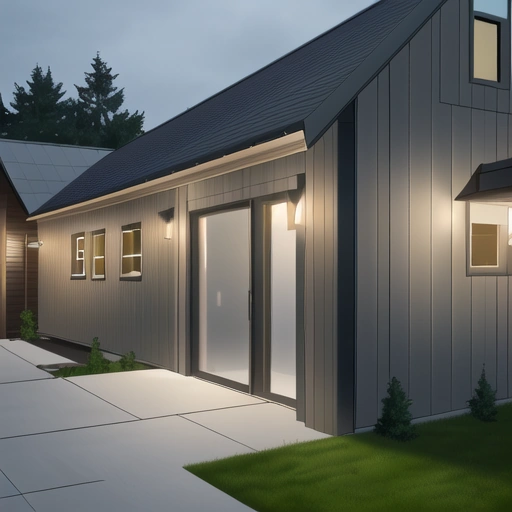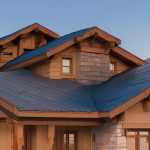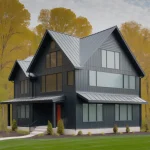Comparing Modern Siding Options for Sustainable and Long-Term Use
The Future of Home Exteriors: Sustainable Siding Solutions
The quest for durable, aesthetically pleasing, and environmentally responsible building materials has never been more critical, especially as homeowners become increasingly aware of the long-term implications of their choices. Siding, the protective skin of our homes, plays a pivotal role that extends far beyond mere aesthetics. It’s a key determinant of energy efficiency, providing crucial insulation against temperature fluctuations, and a primary defense against weather, preventing water damage and structural decay. Moreover, the right siding significantly boosts curb appeal, influencing property values and contributing to neighborhood aesthetics.
As homeowners increasingly prioritize sustainability and long-term value, the market has responded with a diverse array of modern siding options, each with its own set of benefits and drawbacks. This evolution reflects a broader shift towards green building practices and a growing demand for durable siding solutions that minimize environmental impact. This article delves into the leading contenders in the sustainable siding market, comparing their environmental impact across their entire lifecycle, from raw material extraction to manufacturing, installation, and eventual disposal or recycling.
We’ll assess their longevity, examining expected lifespans and resistance to common threats like pests, fire, and moisture. Maintenance requirements, a crucial factor in long-term cost-effectiveness, will also be thoroughly evaluated. Finally, we’ll provide a comprehensive cost analysis, considering both upfront expenses and potential savings on energy bills and future repairs. Our goal is to equip you with the knowledge necessary to make an informed decision, balancing environmental responsibility with practical considerations for your home exterior.
Key options explored will include fiber cement siding (like James Hardie), engineered wood siding (such as LP SmartSide), vinyl siding, and metal siding. Beyond the core attributes, we will also explore the aesthetic versatility of each siding option. The design possibilities for home exteriors are vast, and the right siding can dramatically enhance a home’s architectural style. For example, fiber cement siding offers a wide range of textures and colors, mimicking the look of natural wood without the associated maintenance. Engineered wood siding provides a similar aesthetic appeal while often incorporating recycled content. Metal siding, particularly aluminum and steel, can lend a sleek, modern look to a home. Vinyl siding remains a popular choice due to its affordability and extensive color options. Ultimately, the best siding choice will depend on a homeowner’s individual priorities, balancing sustainability, durability, aesthetics, and budget to create a beautiful and environmentally responsible home.
Fiber Cement Siding: Durability Meets Sustainability
Fiber cement siding, spearheaded by brands like James Hardie, has risen to prominence as a leading choice in modern home exteriors. This composite material, crafted from cement, sand, and cellulose fibers, offers a robust defense against common threats like fire, pests, and rot, making it a durable siding option. Its impressive lifespan, often exceeding 50 years, translates to a substantial return on investment for homeowners. Real-world examples abound, with homes across diverse climates showcasing the enduring performance of fiber cement siding, resisting damage from harsh sun in Arizona to damp conditions in the Pacific Northwest.
This longevity minimizes the need for frequent replacements, directly contributing to its sustainability profile by reducing material waste over the long term. From a sustainable living perspective, fiber cement presents a mixed bag. While it utilizes abundant raw materials, the energy-intensive manufacturing process necessitates careful consideration. The production of cement, a key component, is known for its carbon footprint. However, advancements in manufacturing techniques are gradually reducing this impact, with some manufacturers exploring alternative cement formulations and carbon capture technologies.
Furthermore, proper disposal and recycling programs are crucial to minimize the environmental impact at the end of its lifespan. Homeowners should inquire about the manufacturer’s sustainability practices, including their efforts to reduce emissions and utilize recycled content, when selecting fiber cement siding. Installation of fiber cement siding demands specialized skills, contributing to the overall project cost. The material is heavier and more brittle than alternatives like vinyl, requiring specific cutting tools and fastening techniques to ensure a proper and lasting fit.
Improper installation can compromise its performance and longevity, negating its inherent benefits. However, the long-term savings from reduced maintenance and replacement costs often outweigh the initial investment. Its versatility in mimicking the appearance of wood, stucco, or brick also makes it a popular choice for homeowners seeking aesthetic flexibility without sacrificing durability. Despite these considerations, the combination of longevity, low maintenance, and resistance to common threats makes fiber cement siding a compelling choice for homeowners prioritizing a durable and sustainable siding option for their home exterior.
Engineered Wood Siding: The Sustainable Alternative to Traditional Lumber
Engineered wood siding, exemplified by products like LP SmartSide, has emerged as a strong contender in the home exterior market, offering a compelling alternative to traditional wood siding. This innovative building material is crafted from wood strands, meticulously bonded with durable resins and fortified with waxes to create a robust barrier against moisture, pests, and decay. Unlike solid wood, engineered wood siding exhibits superior dimensional stability, significantly minimizing the potential for unsightly warping, splitting, or cracking over time.
This enhanced stability translates to reduced maintenance and a longer lifespan, making it a practical and aesthetically pleasing choice for homeowners seeking the classic look of wood without the inherent drawbacks. For exterior design, this means cleaner lines and fewer imperfections over the life of the siding, improving curb appeal for longer. From a sustainable living perspective, engineered wood siding presents several advantages. It often utilizes fast-growing, sustainably harvested timber, contributing to responsible forest management and minimizing deforestation.
This aligns with the principles of green building, where materials are sourced and manufactured with minimal environmental impact. Furthermore, the manufacturing process allows for the utilization of wood that might otherwise be considered waste, maximizing resource efficiency. For example, some manufacturers participate in programs that ensure responsible forestry practices, earning certifications that demonstrate their commitment to sustainability. However, it’s important to note that the resins used in the manufacturing process can raise concerns about volatile organic compounds (VOCs), which can impact indoor air quality.
To mitigate potential VOC emissions, proper sealing and finishing of engineered wood siding are crucial. Selecting low-VOC or zero-VOC paints and sealants can further minimize environmental impact and ensure a healthier indoor environment. Additionally, advancements in manufacturing processes have led to the development of engineered wood products with significantly reduced VOC content. Homeowners should research and choose products that meet stringent environmental standards and certifications. Beyond VOCs, the long-term durability of engineered wood siding contributes to its sustainability profile by reducing the need for frequent replacements, thus conserving resources and minimizing waste. This long-term performance, coupled with responsible sourcing and manufacturing practices, positions engineered wood as a more environmentally conscious choice compared to some other siding options. Engineered wood siding provides an appealing balance of aesthetics, durability, and environmental responsibility, making it an increasingly popular choice for homeowners seeking a wood-like appearance with enhanced performance and a smaller environmental footprint.
Vinyl Siding: Balancing Affordability and Environmental Impact
Vinyl siding remains a widely used and affordable option for homeowners seeking to update their home exterior. Made from polyvinyl chloride (PVC), it is lightweight, easy to install, and requires minimal maintenance, contributing to its enduring popularity. Vinyl siding’s appeal also lies in its design versatility; it is available in a vast array of colors and styles, including options that mimic the look of wood grain or traditional clapboard, offering homeowners considerable design flexibility without the upkeep demands of natural wood.
This adaptability makes it a practical choice for a wide range of architectural styles and personal preferences. For budget-conscious homeowners, vinyl siding presents an attractive balance between initial cost and long-term performance. However, the environmental profile of vinyl siding is a subject of ongoing debate within the green building community. PVC production can release harmful chemicals, such as dioxins, and vinyl siding is not biodegradable, posing challenges for disposal and contributing to landfill waste. While advancements have been made in reducing the environmental impact of PVC manufacturing, concerns persist regarding the lifecycle of vinyl siding.
Recycling programs for vinyl siding are becoming more prevalent, with some manufacturers offering take-back programs for end-of-life materials, but the infrastructure is not yet widespread, and participation rates remain relatively low. The industry is actively exploring alternative formulations and recycling technologies to address these concerns and improve the sustainability of vinyl siding. Despite its environmental drawbacks, vinyl siding’s durability and ease of maintenance contribute to its long-term value proposition. Modern vinyl siding is engineered to withstand harsh weather conditions, including high winds, hail, and extreme temperatures, without warping, cracking, or fading.
Many vinyl siding products come with warranties of 20 years or more, providing homeowners with peace of mind and reducing the need for frequent replacements. Furthermore, vinyl siding is resistant to pests and rot, eliminating the need for costly treatments and repairs associated with wood siding. When evaluating vinyl siding, homeowners should consider factors such as the thickness of the material, the quality of the finish, and the manufacturer’s warranty to ensure optimal performance and longevity.
While not the most sustainable choice when compared to fiber cement siding or metal siding, advancements are being made to improve its environmental footprint. Ultimately, the decision to use vinyl siding involves weighing its affordability and practicality against its environmental impact. Homeowners who prioritize sustainability may want to explore alternative siding options, such as engineered wood siding from LP SmartSide or fiber cement siding from James Hardie, which offer a better balance between environmental performance and durability. However, for those on a tight budget or seeking a low-maintenance siding solution, vinyl siding remains a viable option. Responsible homeowners can mitigate the environmental impact of vinyl siding by choosing products with recycled content, participating in recycling programs, and properly maintaining their siding to extend its lifespan.
Metal Siding: Durability and Recyclability in a Modern Package
Metal siding, particularly aluminum and steel, presents a compelling option for homeowners prioritizing durability, sustainability, and a modern aesthetic for their home exterior. Both materials offer exceptional resistance to fire, pests, and extreme weather conditions, surpassing many other siding choices in longevity. Metal’s inherent strength translates to a robust protective layer, reducing the need for frequent repairs or replacements, a key consideration in long-term cost savings and resource conservation. Furthermore, the inherent durability of metal siding protects homes from the elements, preventing moisture damage that can lead to structural issues and costly repairs.
This makes metal siding a strong contender when evaluating building materials for both new construction and home improvement projects focused on resilience. One of the most significant advantages of metal siding lies in its recyclability and potential for recycled content. Aluminum and steel siding are frequently manufactured using a substantial percentage of recycled materials, lessening the demand for virgin resources and minimizing the environmental impact of production. At the end of its lifespan, metal siding can be readily recycled, contributing to a circular economy and diverting waste from landfills.
This aligns with green building practices that emphasize resource efficiency and waste reduction. However, it’s important to acknowledge that the initial manufacturing process for metal siding can be energy-intensive, requiring careful consideration of the overall environmental footprint. Homeowners should inquire about the manufacturer’s commitment to sustainable practices and energy efficiency in their production processes. While steel siding generally offers superior impact resistance, it’s also heavier and more susceptible to rust than aluminum. To combat corrosion, steel siding typically requires protective coatings, such as zinc or specialized paints, adding to the initial cost.
Aluminum siding, on the other hand, is naturally rust-resistant and lighter, simplifying installation. However, it’s more prone to denting, particularly from hail or falling debris. The aesthetic of metal siding, with its clean lines and industrial feel, may not appeal to all homeowners, but advancements in manufacturing have expanded the range of available styles and colors. Embossed textures and various panel designs can mimic the look of wood or other traditional siding materials, broadening its appeal within the exterior design landscape. Ultimately, metal siding offers a sustainable and long-lasting option for homeowners seeking a modern and durable home exterior, provided the aesthetic aligns with their vision.
Making the Right Choice: A Sustainable Siding Strategy
Choosing the right siding is a multifaceted decision, demanding a careful evaluation of durability, sustainability, aesthetics, and cost – all crucial elements for any homeowner embarking on a home improvement project. Fiber cement siding, exemplified by brands like James Hardie, and metal siding stand out for their exceptional longevity and resistance to the elements, offering decades of protection against harsh weather and potential damage. Engineered wood siding, such as LP SmartSide, presents a compelling, more sustainable alternative to traditional lumber, minimizing deforestation and waste.
Vinyl siding, while remaining a budget-conscious choice, necessitates a thorough consideration of its environmental impact, particularly regarding its production and disposal. Ultimately, selecting the ideal siding material requires a holistic approach, balancing immediate financial considerations with long-term performance and environmental responsibility. Beyond the basic material properties, homeowners should delve into the specific performance characteristics of each siding option in relation to their local climate. For instance, in regions prone to wildfires, fiber cement siding or metal siding offer superior fire resistance compared to vinyl or wood-based products.
Coastal areas with high humidity and salt spray demand siding options like certain types of metal or treated engineered wood that can withstand corrosion and moisture damage. Energy efficiency is another critical factor; consider the R-value of the siding and whether it can be combined with insulation to reduce heating and cooling costs. Understanding these nuances allows for a more informed decision, ensuring the chosen siding not only enhances the home’s aesthetic appeal but also contributes to its long-term structural integrity and energy performance.
Furthermore, the aesthetic considerations should extend beyond mere color and style to encompass the overall architectural harmony of the home. The texture, profile, and installation details of the siding can significantly impact the curb appeal and perceived value of the property. For example, horizontal lap siding offers a classic, timeless look, while vertical siding can create a more modern and contemporary feel. Consider how the siding complements the existing architectural features of the home, such as windows, doors, and roofing. Paying attention to these details ensures that the new siding enhances the home’s overall design and creates a cohesive and visually appealing exterior. By understanding the strengths and weaknesses of each material, homeowners can make informed decisions that align with their values and priorities, ensuring a sustainable and long-lasting home exterior, and contributing to green building practices.


